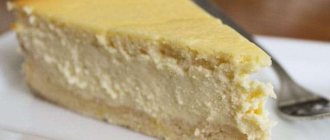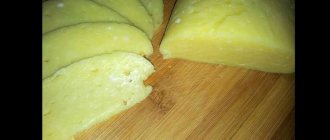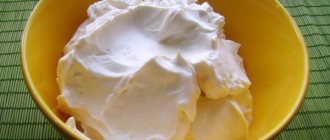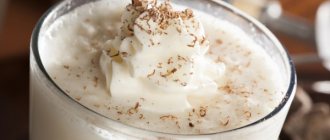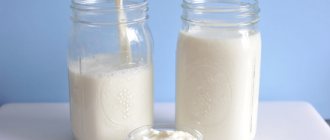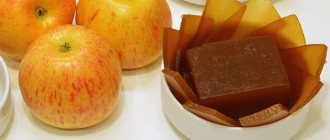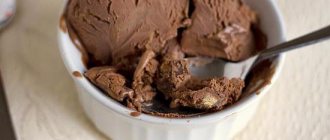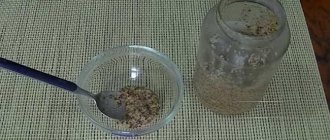Ricotta! This Italian cheese, made from fresh sheep's or cow's milk, is often confused with cottage cheese. Indeed, at a quick glance you can detect its similarity to a more familiar dairy product, both in appearance and texture. However, having tried ricotta at least once, you will understand what makes its taste unique and appreciate it. It belongs to the category of fresh cheeses with a soft and smooth texture and a slightly fresh, but very delicate taste. However, this largely depends on the type of ricotta. Its most popular type is used to prepare a variety of desserts, salads, and also as a filling for pizza and pasta. Like the cheese itself, most dishes containing it are of Italian origin. And this country knows a lot about delicious food! Next, we will take a closer look at what features ricotta has, the recipe for its preparation and options for use.
Ricotta and cottage cheese: what's the difference?
The word “Ricotta” (Italian: ri-cotta) translates as “overcooked.” Already from the moment of production, one can trace its significant difference from ordinary cottage cheese. The latter is obtained by heating milk, to which rennet is added, as a result of which it coagulates and casein precipitates. This completes the cooking process. However, to make cheese, this precipitate is reheated and combined with an enzyme. The resulting top layer will be called ricotta.
Varieties
It should be noted that the preparation process depends on the specific type of cheese. Homemade ricotta is prepared using the method described above and is very tender in both consistency and taste. This is Ricotta fresca. It is the basis of numerous Italian desserts, salads and light fillings for other dishes. However, there are other varieties, for example, Ricotta salata, which has a salty taste and replaces grated Parmesan in a number of recipes. Or Ricotta affumicata - smoked mature cheese, which can be either an independent snack or used as one of the components in grated form. And also many others. All of them are good in their own way, but we are interested in the classic version of ricotta cheese. The recipe for its preparation will be described in detail in this article.
Varieties of ricotta
Depending on the preparation technology and where the cheese will be used, the following types of ricotta are distinguished:
- Fresh (Fresca).
- Al Forno - cooked in the oven, has a chocolate or fruit flavor.
- Romana is a soft cheese that is aged for a long time and made salty.
- Forte - made from sheep's milk. This ricotta retains its taste much longer, because it is prepared in a special way. So, the cheese is placed in a clay dish and stirred daily until it reaches the desired acid level. This product should be stored in a glass container and used mainly as a filling for sandwiches.
- Affumicata - prepared from goat milk, after production it can be smoked.
There are also two more varieties of real Italian cheese:
- Romana is ricotta made from sheep whey with the addition of milk from sheep grazed exclusively in Tuscany. It is distinguished by its tuberous structure, white color and sweet taste.
- Ricotta di Buffalo - prepared from buffalo whey and milk in four provinces - Molise, Campania, Lazio and Apulia; The color of this cheese is white porcelain, there is no crust, the structure is soft and delicate, the taste is sweetish.
Cooking at home: what ingredients are needed?
Despite the high cost of the cheese mentioned in domestic stores, the products for its preparation are more than affordable both in price and in availability. There are few main components, and the main one is milk. You can use both low-fat and whole. The latter is preferable (even better if you can get a rustic one), since the taste of the finished product will be creamy and very delicate. What additional ingredients are needed for ricotta cheese? A recipe for four liters of milk will require:
- fine salt - a teaspoon;
- sugar - two large pinches;
- freshly squeezed lemon juice - half a cup (you can replace it with white vinegar, but don't).
As already mentioned, real ricotta is made from whey. Therefore, as a result of the first stage, we will get a “by-product” in the form of cottage cheese, which you will certainly find a use for. And already at the second stage we will prepare the planned dish. Often, ricotta cheese at home is nothing more than cottage cheese. Most housewives stop at the initial result and the precipitate formed during heating is called Italian cheese. But we are not looking for easy ways and will do everything according to the rules.
Homemade ricotta made from milk and cream
Cooking time: 1 hour 20 minutes. Number of servings: 2-3. Equipment: a saucepan with a capacity of at least 5 liters, a colander, thick gauze, a slotted spoon, a bowl or a small saucepan.
Ingredients
| Milk | 4 l |
| Cream 20% fat | 1-2 tbsp. l. |
| Lemon acid | 1 tsp. |
| Water | 1 tbsp. l. |
| Salt | pinch |
Step-by-step preparation
- Pour 4 liters of milk into a saucepan and heat over medium heat to 85 degrees.
- Dissolve 1 teaspoon of citric acid in 1 tablespoon of water and pour into heated milk.
- Continue heating, stirring constantly. You need to stir carefully so as not to break the resulting grains of cheese.
- Place a colander covered with gauze in a small saucepan. Use a slotted spoon to transfer the resulting cheese into it.
- Cover the ricotta with cheesecloth and let sit for 1 hour. The longer the cheese sits, the drier it ends up.
- Transfer the finished ricotta to a bowl, add salt as desired and stir 1-2 tablespoons of heavy cream into the cheese. For variety, you can add chopped herbs to the cheese.
Video
It's hard to believe, but making ricotta is much easier than many housewives think. And you can treat yourself to this delicate cheese immediately after it has cooled.
First stage: obtaining serum
Pour the milk into a saucepan with a thick bottom and heat to approximately 90 degrees over very low heat. Then add half the lemon juice and salt, sugar. Stir thoroughly. After just a couple of seconds, you should find that the milk is curdling and flakes are forming on its surface. After this, remove the pan from the stove, cover with gauze and let the contents cool. Then we strain the curd sediment and wait until the whey has completely drained. We put the resulting curd in the refrigerator - it can be used for some baking or eaten with fruits and berries.
Step two: making ricotta
We heat the cooled whey again - first to 38-40 degrees. However, it should not be disturbed. Then remove from heat and let it brew for an hour. We put it on the stove again and bring it to a temperature of 90-93 degrees, making sure that the liquid does not boil. While stirring, pour in the second half of the lemon juice. Continue heating the mixture over low heat for 5 minutes, then remove and cool. After this, the pan needs to be put in the refrigerator for quite a long time - up to 10 hours. If you do this in the evening, then in the morning you can take it out and drain it using a colander and a triple layer of gauze. Leave to express completely for several hours. Now your homemade ricotta is ready. This recipe is somewhat more complicated, since you have to do double work - get the whey and make cheese from it. However, you can simplify your task by buying a ready-made base, for example, at the market from sellers of village products. Often, in addition to homemade sour cream, milk, fermented baked milk and other things, they offer customers the whey left over from making cottage cheese. This is what we need!
Whey ricotta
No less tasty and tender ricotta is made from whey. The ingredients for its preparation are quite simple and accessible:
- 7-8 liters of whey;
- 50 ml 9% apple cider vinegar;
- half a teaspoon of coarse salt.
Step-by-step preparation of ricotta from whey
- Pour the whey into a large saucepan and heat it to 90 degrees, avoiding boiling.
- As soon as the whey begins to boil, pour apple cider vinegar into the pan and stir the contents.
- Once curdled flakes begin to appear on the surface of the whey, remove the pan from the heat and leave to cool to room temperature.
- After a few hours, when the mixture has cooled, drain it over a colander lined with gauze.
- Adjust the dryness (humidity) of the serum yourself.
Ricotta in cooking: uses
Salt the resulting cheese a little, transfer it to a container and put it in the refrigerator to strengthen the texture. Now you have almost real ricotta cheese. The recipes in which it can be used are many and varied. First of all, these are Italian desserts. Typically, ricotta is mixed with other cream cheeses or just heavy cream and whipped to a fluffy, creamy consistency. This base goes perfectly with berries, light biscuits or various fruit purees. In addition, ricotta cut into pieces can be added to fresh vegetable salads (replacing, for example, salted feta), to pasta sauces (creamy, mushroom, etc.) or used as a topping for thin Italian pizza in combination with tomatoes and fresh juicy herbs .
Whey ricotta cheese
Many people mistakenly believe that soft ricotta cheese is no different from regular cottage cheese. The taste qualities of these products cannot be compared. Cottage cheese has a more crumbly consistency with a sour taste and is prepared from whole milk by acidifying it. The resulting clots form cottage cheese. The principle of preparing ricotta is fundamentally different. The Italians put it into the very name of the product “ri-cotta”, which means “overcooked”. Smooth and sweetish curd cheese can be made from whey. To prepare at home you need:
- 6 l. fresh whey;
- 1 liter of milk;
- 80 ml. wine vinegar.
Whey cheese according to the Italian recipe is prepared as follows:
- In a large enamel container, combine the whey and milk. Heat until warm. You need to keep the mixture in this form for about an hour. If the milk curdles, it doesn't matter.
- After an hour, carefully heat the pan to the point before boiling, but do not boil. Stir constantly so that it doesn't burn.
- Add vinegar. After 5 minutes of continuous stirring, remove the container from the stove.
- Cool the whey with milk and vinegar, then put it in the refrigerator for 10 hours.
- Place the mixture in a colander lined with gauze. Leave in this state for 6 hours.
Homemade ricotta cheese is ready. Add salt to taste and transfer to a convenient container. Store it in a cool place and use it as an addition to any appetizers or lasagna. You can simply consume it with honey and fruits as a healthy dessert.
